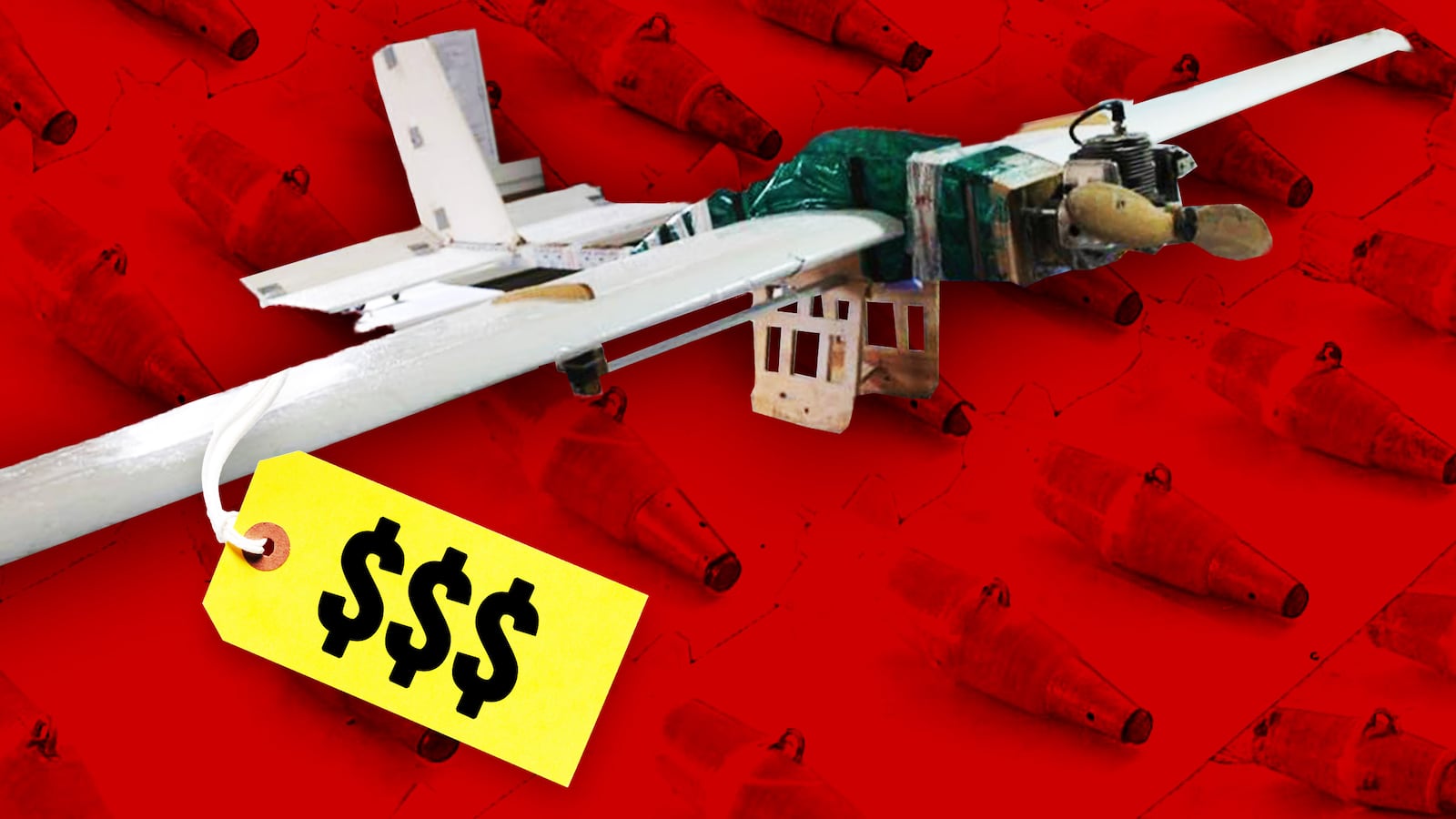Russia has all but accused the U.S. military of being behind the improvised drone attack on its air base in Syria last week, claiming the aircraft could have only come from a major military power like the United States.
But days before the unique, jury-rigged drone bomber surfaced in the attack, a seller in a rebel social media arms market based in Syria’s Idlib province posted an advertisement for an identical-looking model of rickety homebrew drone along with similar munitions, casting serious doubt on Moscow’s tales of high tech transfer.
Russia’s defense ministry says the attack took place in the early hours of Jan. 6, involving a swarm of 10 bomblet-armed drones aimed at the Hmeimim air base in Latakia and an additional three drones targeted at the Russian naval base in Tartus—all guided by GPS navigation. On Wednesday, Russia’s defense ministry released a statement claiming that “moderate opposition” fighters in Syria had launched the drones from Idlib and called on Turkey to provide greater security in the province as part of its participation in a Russian-sponsored peace plan for the conflict.
The incident, aimed at the heart of the Russian military presence in Syria, struck a blow to the triumphalist talk of final victory against Syria’s insurgency, coming just a little over a month after a Russian President Vladimir Putin’s visit to the base for a George W. Bush-style declaration of “mission accomplished.”
The attack, still unclaimed by any rebel group, triggered a conspiratorial outlash from Russia, where “a source in the Russian Defense Ministry” darkly hinted to the state-run TASS news agency that the presence of a U.S. Navy reconnaissance plane in the Mediterranean may have had something to do with the attack and that the drone’s use of GPS guidance pointed towards nation-state involvement.

But the black market drone advertisement, posted on Dec. 31 in a Telegram arms market where rebels trade everything from motorcycles to machine guns, suggests that the weapon may have been available to any rebels who had the cash to buy it. The seller offered the drone alongside two small, grenade-sized munitions. “Brothers,” the author wrote next to pictures of the weapons, “reconnaissance plane which drops shells for sale.”
The Daily Beast reached out to the seller with questions about the aircraft and its usage but received no reply.
In a Facebook post after the air base attack, Russia’s defense ministry wrote that its electronic warfare systems defeated six of the drones and that its Pantsir air defense systems shot down an additional seven during the attack. Photos accompanying the post reveal a nearly identical drone to that seen in the Telegram arms market with the same boxy fuselage covered in green plastic wrap and tape, capped by a wood casing surrounding the engine.
Captured munitions from the photos posted by the Russians also show starkly similar munitions to the ones offered on Telegram, with semi-transparent casings, white plastic fins, and a thick metal hook to attach them underwing. The bombs contain “BB’s embedded in epoxy around an explosive core and then placed in an aerodynamic plastic shell,” says Nick Waters, an analyst who researches for Bellingcat, an investigative journalism nonprofit. “They were designed for fragmentation rather than destroying planes.”
But the Hmeimim incident wasn’t the first sighting of that particular model of slapdash drone in the wild. On Jan. 1, the day after the black market drone posting, Saray al-Areen, an Assad regime-aligned militia, posted pictures of another identical drone with similar munitions fragments on its Facebook page, writing that it had captured “two aircraft with munitions outside of Qeraha and Jablah,” villages not far outside the Russian air base at Hmeimim. “The explosions heard today at noon are the results of these shells,” the group advised.
The capture followed a New Year’s Eve attack on Hmeimim which killed two Russian troops and which Russian authorities subsequently described as a mortar attack.
Then again on Jan. 2, wreckage from what appears to be another of the same model drone surfaced in a separate attack. The Russian publication Rusvesna published pictures of wreckage sporting the same same green tape, plastic and plywood-covered engine, claiming that the aircraft had been launched by the Islamist Ahrar al-Sham rebel group at a Russian military engineers’ training facility in northern Homs province before being shot down by local troops.
The aircraft has a unique, improvised design, which doesn’t appear to come from any known commercial models or kits, suggesting a stronger connection between the drone offered for sale on Telegram and the models captured by Russian and Syrian forces. “From what I can see, this ‘drone’ was fabricated using wooden parts and tape. Perhaps the servos and engine were purchased online, although it’s more likely been scavenged from a model airplane,” says Mike Blades, a drone industry analyst at Frost & Sullivan.

In its Facebook post, Russia’s Ministry of Defense talks up the aircraft as a near technological wonder, claiming that they were launched from as far as 50 kilometers away and possibly “received from one of countries with high-technological capabilities of satellite navigation and remote dropping control of professionally assembled improvised explosive devices in assigned coordinates.”
The Pentagon denied the suggestion of any complicity in the attack, with a spokesperson saying the suggestion is “without any basis in fact and is utterly irresponsible.” But the conspiratorial tone insinuating a link between terrorist groups and Western countries is in keeping with the flavor of Russian officialdom’s pronouncements on Syria as of late, accusing the U.S. of complicity in the Islamic State’s killing of a Russian general in eastern Syria and claiming that U.S.-backed Kurdish anti-Islamic State rebels are in league with the terrorist group.
The tale of skulduggery is belied not just by the ministry’s own imagery of a craptastic shambles-mobile held together with duct tape, but a long record of homebrew drone construction and commercial usage by militants in Syria and Iraq.
The Islamic State pioneered the use of commercial drones as grenade-bombers throughout its reign in Syria and Iraq, co-opting the popular DJI Phantom model of quadrotor as its bomber of choice and using it to harass and slow down the advance of U.S. and Iraqi troops during the siege of Mosul. Forensic research by Conflict Armament carried out at captured ISIS weapons workshops in Iraq shows the group went so far as to manufacture custom fuses and casings for its drone munitions, even experimenting with larger, purpose-built drone airframes.
The popularity of small drone bombers now spans the ideological gamut of terrorist groups, ranging from Iranian-backed Hezbollah to the Kurdistan Worker’s Party (PKK). The tactic has even garnered limited interest from governments with Iraqi Federal Police turning the tables on ISIS and dropping their own quadrotor-borne munitions on the group. The raw materials for a drone bombers—explosives, fuses, and commercial drones—are also traded openly on social media arms markets, which act as a kind of rebel Craigslist for small arms, letting users piece together their own artisanal arsenals.
That widespread popularity of homemade drone weapons in Syria, combined with the easy availability of parts to make them, puts the kind of drone bombers within reach of a broad array of rebel groups. With Syria's declining insurgency still clinging to life, that means Russia and the Assad regime are likely to face more homebrew drone attacks like the one against Hmeimim air base.







